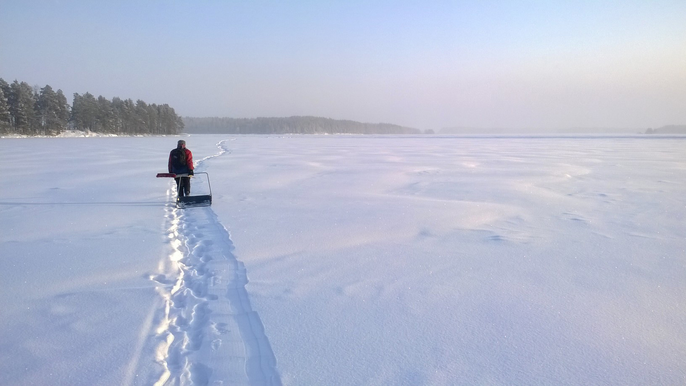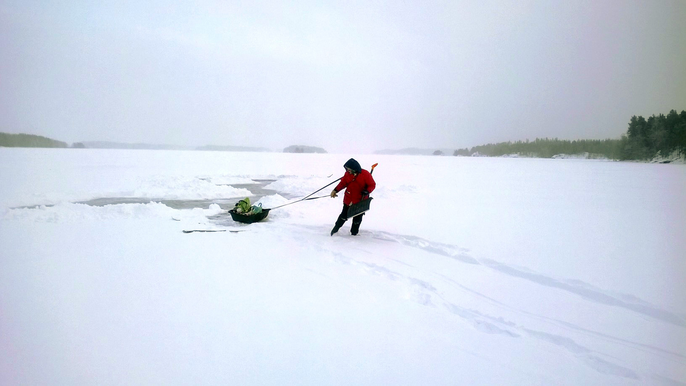Over the years, the place has gained new meanings. The process of giving meanings is continuous. It is influenced by the environment with its changes, as well as by my current goals, thoughts, feelings and bodily senses. The understanding of the place changes and lives like a reflection on the surface of the water. The place is not just what I experience on the specific physical spot but also the places that have come to my memories and experiences. These different places are constantly interacting with each other and guiding my observations and interpretations.
From the environment aesthetic, I adopt the approach that the environmental experience is not just a visual but also always a multisensory experience (Berleant 1999, 31–32). From cultural studies, I also adopt the understanding that the environment that is intimately experienced becomes a personal place in the world, embroidered with one’s memories and expectation (Karjalainen 2004, 55). The experience of the place combines material flow and sensuous presence. Here, experience is a multi-layered event where the culture and one’s earlier experiences affect the new experiences. In the experience the sensations, emotions, memories, thoughts and fantasies interact. The experience is simultaneously sensual and cognitive–affective. Thus, there are many elements reaching across the generations in how we experience the environment. The sun and moon have glittered in the cracks of ice and made people see visions since time immemorial. The vastness of the surrounding nature and the cultural memories mix in my internal visions and produce the experiences and their interpretations.
The relationship between humans and nature has been explained in many ways. According to the theory of evolution, people have an inherent tendency to prefer the natural environment in relation to the built and urban environment. This also implies that human species are characterised by movement in nature. According to the opposite theory, the meanings attached to nature are learned and culturally related. Because of this culturally related relationship, the attitudes to nature vary even within the same period. For example, the Finns’ relationship with the forest as northern coniferous forest inhabitants is different from that of the Central Europeans (Järviluoma J., 2006, 76–91). Then there are several theories combining these two perspectives, like those of the cultural geographers Pauli Tapani Karjalainen and Yi-Fi Tuan. From my point of view, the dominant point lies in the aesthetic approach (see Sepänmaa 2018, 23–24) combined with cultural meanings, such as stories and beliefs about the universe. According to Tim Ingold (2000), the environment is something that surrounds us; therefore, it does not exist without the experience. Nature is one dimension of the environment. A person’s relationship with the environment comes from her or his life experience. However, there are two fundamentally different approaches or perspectives to the environment. From a global perspective, it is typical to see nature separate from humanity through categorisation and global images. From a dwelling perspective, humans are part of nature. The landscape is a continually unfolding story. The dwelling perspective produces a wealth of different ways to view the environment, and the subject is more exposed to the effects of the environment. However, there is no solid relationship between nature and human beings; rather, the perspectives interact. Thus, the local level can interact with the regional and national perspectives (Ingold 2000, Vikman 2007).
From the photography perspective, the main time for shooting is the early winter, when the black, unfrozen water can be seen through the thin ice cover. The white icy cracks against this black water forms a dramatic canvas for my imagination. Especially in the darkness of the evening, a white crack or white point against the black water is easily associated with cosmic views. Along this association, the understanding of one’s position widens from the local situation to the cosmic sphere. Thus, the place generates expanding interpretative circles about the immediate, nearby and cosmic places and spaces. Furthermore, the understanding of the periphery floats along this process. In my case, it is possible to find several expanding circles of the place. Horizontally, the core physical place consists of my restricted area of shooting and working. Then, there is the entire ice covered lake continuing to the horizon. Somewhere, there is an interior, a house that offers safety and a place for processing the icy experiences. Behind this comes the forest, the neighbourhood, the village. Looking vertically upward, the shooting place enlarges from the surface to the air I breathe and the wind, clouds, and finally, cosmic spheres. Correspondingly, underneath my feet, I apprehend the surface, the deepening water and the bottom. Somewhere beyond all these directional dimensions, there are the mythical places created by our culture and my mind.
From the spatial point of view, the periphery widens in two directions—to the cosmic sphere and to the micro-cosmos. One has the uttermost awareness of the vastness of the macro-cosmos and one’s place there. This also activates the inner conversation with several cosmological myths and poems, like the myths of the beginning or the structure of the world and poems on the solitude of human beings or different kinds of mythical travels across the universe. I can see the echoes of this kind of conversation in my photos A cosmic landscape (2013) and Axis mundi (2017). The first series shows how a tiny white point on the frozen lake is interpreted from the cosmic point of view. The second one shows how a white frozen crack is interpreted via a cosmological myth about the structure of the world, axis mundi.
The place where I shoot most of my images is Lake Saimaa in Eastern Finland. The area belongs to the lake natural park area. Numerous small islands have no permanent habitat. In addition, the leisure facility is rarely accessible and small. The area is strictly regulated by the Ministry of the Environment, which mandates where visitors can move and when. The Saimaa is also home to a rare and almost extinct swamp. In summer, there are many leisure boaters and fishermen in the waters of Saimaa. For my photographing ice the winter with its silent and ever-changing ice cover is the core time.
Photographing the ice is extremely physical. Cracks of interest for photography are not necessarily visible as such but must be searched under the snow. This means that, when I go to the ice, I have a lot of different supplies, and often, another person with me. In the early winter, one can go on the ice on foot, but in mid-winter, due to the thickness of the snow cover, only skiing is possible. In addition, we have two sleds, one with different brushes, shovels and scrapers for brushing snow and keeping it clean. The other includes accessories for shooting, including cameras, lenses, tripods and luminaires.
Geographer John Agnew has shown how human belief systems guide the way the world is perceived. In the Western world, in the latest, Copernican worldview, it has been customary since the end of the 15th century to divide the world into two parts—the explored and the unexplored. The explored areas are determined by order and development, while the unexplored areas represent chaos and danger (Agnew 2003, 15–33). In the image Expanding circles of the place, one can see how the unexplored area connected with danger and the unknown is confronted quicker on the vertical than it is on the horizontal axis. The danger lies near the frozen surface. The more one moves on the ice, the more detailed the place becomes, and the spheres of the unknown float further. Cosiness and danger are intertwined, and the borders of their realms are in a continuous movement. Like cosiness and danger, the mythical and real have a continuous interplay, where the crack on ice created by nature transforms to a mythical axis mundi. As we can see, the expanding circles of the place are not in dichotomous relationships to each other, but they are intertwined and in a continuous process of change in many ways.
In the next section, I unpack the concepts Icephery and the Icy Score. I have created these concepts by concentrating on analysing what kind of information my thermoceptive and auditive orientations will give. The Icephery concept is built more from theory to practice and the Icy Score from practice to theory.





